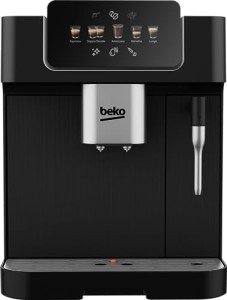The Ultimate Guide to Whole Bean Coffee Machines
In an age where coffee enthusiasts have actually ended up being progressively critical, the choice of a coffee machine has actually become more essential than ever. Real Coffee Machine have actually become a preferred amongst serious coffee drinkers, allowing them to extract the best flavors from coffee beans. This short article digs into the complexities of whole bean coffee machines, exploring their functions, benefits, and considerations for the devoted coffee fan.
What is a Whole Bean Coffee Machine?
A whole bean coffee machine is designed to grind coffee beans prior to developing, guaranteeing maximum freshness and taste extraction. Unlike conventional coffee makers that depend on pre-ground coffee, these machines incorporate a grinder, which enables the user to choose the grind size suited to their developing approach, from espresso to French press.
Advantages of Whole Bean Coffee Machines
- Freshness: The primary benefit of using whole beans is that they keep their flavor longer than pre-ground coffee. Grinding just before brewing protects the aromatic oils that contribute to the overall flavor profile.
- Customization: Many whole bean machines permit users to change grind settings, water temperature level, and developing time to create a tailored cup of coffee that meets individual choices.
- Quality assurance: Whole bean coffee machines empower users to select premium beans from numerous sources, making it simpler to explore distinct taste profiles.
- Adaptability: These machines cater to different brewing methods, enabling users to craft espresso, drip coffee, or specialty brews with ease.
- Convenience: Integrated grinders simplify the coffee-making procedure, decreasing the need for additional equipment and minimizing clean-up.
Secret Features to Consider
When picking a whole bean coffee machine, a number of functions ought to be thought about:
Grinder Type:
- Burr vs. Blade: Burr grinders provide a more uniform grind, which is vital for consistency in taste, whereas blade mills tend to produce unequal grinds.
- Brew Method Compatibility: Ensure the machine can accommodate the developing approach chosen (e.g., espresso, pour-over, French press).
- Capacity: Consider the hopper size for holding coffee beans; larger capabilities mean less regular refilling.
- User Interface: Look for machines with intuitive controls, permitting users of all ability levels to run them quickly.
- Maintenance: Machines that are easy to clean and preserve will conserve time and ensure the durability of the device.
- Product Quality: Stainless steel and state-of-the-art plastic deal durability, while machines with glass elements tend to be less resilient.
Popular Whole Bean Coffee Machines
| Brand name | Model | Mill Type | Capability (Cups) | Features | Cost Range (₤) |
|---|---|---|---|---|---|
| Breville | BES870XL Barista Express | Burr | 8 | Espresso machine, steam wand | 600 - 700 |
| De'Longhi | EC702 | Pump | 10 | Dual boiler system, stainless-steel | 300 - 400 |
| Cuisinart | DCC-3200P1 | Blade | 14 | 24-hour programmable, drip coffee | 50 - 100 |
| Rancilio | Silvia | Burr | 2 | Expert feel, steam power | 700 - 800 |
| Hamilton Beach | 49980A | Mixed | 2 | Single-serve, versatile developing | 30 - 50 |
How to Make the Most Out of Your Whole Bean Coffee Machine
To accomplish the best results with a whole bean coffee machine, think about the following pointers:
- Quality Beans: Always pick high-quality, fresh beans that match your taste.
- Grind Size: Adjust the grind size based on the brewing approach. Finer grinds are suitable for espresso, while coarser grinds work better for French press.
- Developing Temperature: Water temperature must normally be between 195 ° F and 205 ° F (90 ° C -96 ° C) for ideal extraction.
- Water Quality: Use filtered water for the very best flavor and to extend the machine's lifespan.
- Maintenance Schedule: Regularly tidy the mill and machine to prevent residue accumulation and ensure constant performance.
FAQs about Whole Bean Coffee Machines
1. Is a whole bean coffee machine worth the investment?
Yes, if you value the freshness and taste of your coffee, purchasing a whole bean coffee machine is helpful. It enables a richer and more fragrant cup of coffee compared to pre-ground choices.
2. How do I clean my whole bean coffee machine?
Most machines feature cleaning instructions. Usually, you'll require to get rid of the mill, tidy the hopper, and run a cleaning cycle with water. Usage brushes particularly created for this function.
3. Can Bean To Cup Coffee Machines For Home use pre-ground coffee in a whole bean machine?
The majority of whole bean coffee machines are particularly developed for whole beans; nevertheless, some might permit you to utilize pre-ground coffee. Consult the producer's guidelines.
4. What is the very best grind size for espresso?
A fine grind is typically chosen for espresso. However, experimentation can help discover the best grind size that matches your taste choices.
5. How frequently should I replace the coffee beans?
For optimum freshness, it is motivated to utilize coffee beans within two weeks of opening after they have actually been roasted. Shop them in an airtight container away from light and moisture.
A whole bean coffee machine can raise the coffee experience, supplying freshness, personalization, and remarkable flavor. With numerous options offered, potential purchasers can find a machine that fits their lifestyle and coffee choices. By thinking about the previously mentioned functions, pointers for optimization, and maintaining a constant cleansing routine, users can appreciate every cup of freshly brewed, aromatic coffee for years to come. Whether for individual usage or amusing visitors, buying a whole bean coffee machine is an action towards coffee excellence.

